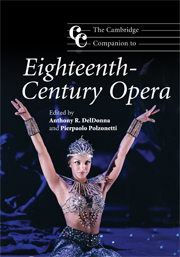Book contents
- Frontmatter
- Part I The making of opera
- 1 Opera as process
- 2 Aria as drama
- 3 Ensembles and finales
- 4 Metastasio: the dramaturgy of eighteenth-century heroic opera
- 5 Roles and acting
- 6 Ballet
- 7 Orchestra and voice in eighteenth-century Italian opera
- 8 To look again (at Don Giovanni)
- Part II National styles and genres
- Notes
- Bibliography
- Index
2 - Aria as drama
from Part I - The making of opera
Published online by Cambridge University Press: 28 September 2011
- Frontmatter
- Part I The making of opera
- 1 Opera as process
- 2 Aria as drama
- 3 Ensembles and finales
- 4 Metastasio: the dramaturgy of eighteenth-century heroic opera
- 5 Roles and acting
- 6 Ballet
- 7 Orchestra and voice in eighteenth-century Italian opera
- 8 To look again (at Don Giovanni)
- Part II National styles and genres
- Notes
- Bibliography
- Index
Summary
The primacy of aria
In eighteenth-century opera, the aria was supreme. Although in practice the distinction was less hidebound than the usual later descriptions would imply, most operas were constructed on the principle of strict alternation between passages of action and dialogue in versi sciolti (free verse, usually in a combination of seven- and eleven-syllable lines), set musically as recitative; and passages of reaction for single characters in closed poetic forms, set musically as fully composed, semantically and expressively significant movements with orchestral accompaniment – that is, as arias. Indeed, almost all the concerted vocal numbers were arias (plus the occasional duet and the very occasional trio); although the gradually increasing proportion and importance of ensembles late in the century (especially in comic operas) qualified this high status, it did not abrogate it. (As in most respects, the tragédie lyrique in France was somewhat different; it was characterized by a more nearly fluid alternation among recitative, arioso, and air, with the air shorter and more nearly integrated into the flow, as well as by an emphasis on chorus and ballet that by and large was foreign to opera in Italian.) However, the primacy of the aria was not merely dramaturgical and statistical, but aesthetic as well. It was reflected in historical tradition and strength of conventions, prestige among theorists and aestheticians, care lavished by composers, identification with star performers and the culture of performativity, and interest on the part of audiences.
- Type
- Chapter
- Information
- The Cambridge Companion to Eighteenth-Century Opera , pp. 24 - 49Publisher: Cambridge University PressPrint publication year: 2009
- 3
- Cited by



